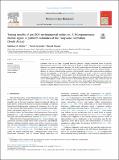Files in this item
Testing models of pre-GOE environmental oxidation : a Paleoproterozoic marine signal in platform dolomites of the Tongwane Formation (South Africa)
Item metadata
| dc.contributor.author | Warke, Matthew R. | |
| dc.contributor.author | Schröder, Stefan | |
| dc.contributor.author | Strauss, Harald | |
| dc.date.accessioned | 2018-05-28T10:30:08Z | |
| dc.date.available | 2018-05-28T10:30:08Z | |
| dc.date.issued | 2018-08 | |
| dc.identifier | 252871246 | |
| dc.identifier | 2b484fe7-edd8-4f0c-aa80-dd4cfd2d8b52 | |
| dc.identifier | 85047439459 | |
| dc.identifier | 000436883700013 | |
| dc.identifier.citation | Warke , M R , Schröder , S & Strauss , H 2018 , ' Testing models of pre-GOE environmental oxidation : a Paleoproterozoic marine signal in platform dolomites of the Tongwane Formation (South Africa) ' , Precambrian Research , vol. 313 , pp. 205-220 . https://doi.org/10.1016/j.precamres.2018.04.015 | en |
| dc.identifier.issn | 0301-9268 | |
| dc.identifier.other | RIS: urn:E1174EF81F50C8D82E60643DF3BAF483 | |
| dc.identifier.other | ORCID: /0000-0001-9830-0383/work/43873428 | |
| dc.identifier.uri | https://hdl.handle.net/10023/13568 | |
| dc.description | MRW was supported by a NERC-studentship through the University of Manchester. SS was supported through a Strategy Grant of the Faculty of Engineering and Physical Sciences at the University of Manchester. | en |
| dc.description.abstract | Carbonate facies of the upper Tongwane Formation preserve a largely overlooked record of pre-GOE Paleoproterozoic seawater. This inventory has survived despite a complex paragenetic history involving both diagenetic and contact metamorphic processes. BIF mineral assemblages are dominated by a medium-grade grunerite overprint and the formation of prograde and retrograde riebeckite. The massive dolomite member, a platform top carbonate which caps the succession, is characterized by marine REYSN patterns lacking significant negative CeSN anomalies (<10%) and δ13Ccarb values of between +1.83 and +2.95 ‰VPDB that are slightly elevated above Paleoproterozoic ‘normal marine’ values. Systematically decreasing δ13Ccarb values measured in monotonously recrystallized, talc bearing, slope carbonates reflect interaction with devolatilization fluids during contact metamorphism caused by the intrusion of the Bushveld Igneous Complex; slope carbonates offer no insight into marine paleoredox conditions. Thus, despite contact metamorphism, Paleoproterozoic marine signals are retained in platform-top dolomites, however they do not support claims for widespread oxygen accumulation in shallow depositional environments of the Transvaal Basin on the eve of the GOE. | |
| dc.format.extent | 16 | |
| dc.format.extent | 3065132 | |
| dc.language.iso | eng | |
| dc.relation.ispartof | Precambrian Research | en |
| dc.subject | Tongwane Formation | en |
| dc.subject | Transvaal Supergroup | en |
| dc.subject | Great Oxidation Event | en |
| dc.subject | Cerium anomalies | en |
| dc.subject | Carbon isotopes | en |
| dc.subject | QE Geology | en |
| dc.subject | NDAS | en |
| dc.subject | SDG 14 - Life Below Water | en |
| dc.subject.lcc | QE | en |
| dc.title | Testing models of pre-GOE environmental oxidation : a Paleoproterozoic marine signal in platform dolomites of the Tongwane Formation (South Africa) | en |
| dc.type | Journal article | en |
| dc.contributor.institution | University of St Andrews. School of Earth & Environmental Sciences | en |
| dc.identifier.doi | 10.1016/j.precamres.2018.04.015 | |
| dc.description.status | Peer reviewed | en |
This item appears in the following Collection(s)
Items in the St Andrews Research Repository are protected by copyright, with all rights reserved, unless otherwise indicated.

